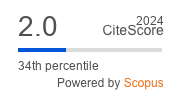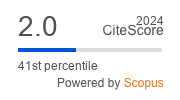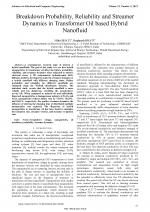| 2/2023 - 8 |
Breakdown Probability, Reliability and Streamer Dynamics in Transformer Oil based Hybrid NanofluidBHATT, M. |
| Extra paper information in |
| Click to see author's profile in |
| Download PDF |
Author keywords
breakdown voltage, nanoparticles, oil insulation, probability, streamer dynamics
References keywords
transformer(11), nanop(9), nanofluids(9), hybrid(9), thermal(8), nanofluid(8), materials(6), today(5), dielectric(5), technology(4)
Blue keywords are present in both the references section and the paper title.
About this article
Date of Publication: 2023-05-31
Volume 23, Issue 2, Year 2023, On page(s): 67 - 74
ISSN: 1582-7445, e-ISSN: 1844-7600
Digital Object Identifier: 10.4316/AECE.2023.02008
Web of Science Accession Number: 001009953400008
SCOPUS ID: 85164362234
Abstract
A contemporary research topic of interest is hybrid nanofluids. The goal of this study is to see how hybrid nanoparticles in transformer oil affect the failure probability, reliability, and streamer dynamics when subjected to massive electrical stress. A 2D axisymmetric hydrodynamic drift-diffusion model is developed to study the streamer dynamics in a hybrid nanofluid with different charging times. Failure probability and reliability for different nanofluids are estimated using the Weibull distribution function. The statistical study reveals that the hybrid nanofluid is more reliable and less dangerous, extending the transformers' service life. When compared to mineral oil and individually dispersed nanoparticles, a homogeneous mixture of Fe3O4 and Al2O3 nanoparticles reduces failure rate by 73.94%, 56.29%, and 30.41%, respectively. For positive streamer dynamics, the influence of altering the charging time of distributed multiple nanoparticles was explored. The dispersion of hybrid nanoparticles in transformer oil has been found to minimize the ionization rate, streamer velocity, and streamer re-ignition rate. |
| References | | | Cited By «-- Click to see who has cited this paper |
| [1] M. Rafiq, M. Shafique, A. Azam, M. Ateeq, "Transformer oil-based nanofluid: The application of nanomaterials on thermal, electrical and physicochemical properties of liquid insulation - a review," Ain Shams Engineering Journal, vol. 12, no. 1, pp. 555-576, 2021. [CrossRef] [SCOPUS Times Cited 86] [2] R. Ekiciler, "Effects of novel hybrid nanofluid (TiO2-Cu/EG) and geometrical parameters of triangular rib mounted in a duct on heat transfer and flow characteristics," Journal of Thermal Analysis and Calorimetry, vol. 143, pp. 1371-1387, 2021. [CrossRef] [SCOPUS Times Cited 34] [3] J. Yu, A. Wang, M. Zhang, Z. Lin, "Water treatment via non-membrane inorganic nanoparticles/cellulose composites," Materials Today, vol. 50, pp. 329-357, 2021. [CrossRef] [SCOPUS Times Cited 47] [4] Q. Mu, G. Lin, M. Jeon, H. Wang, F. Chang, R. Revia, J. Yu, M. Zhang, "Iron oxide nanoparticle targeted chemo-immunotherapy for triple negative breast cancer," Materials Today, vol. 50, pp. 149-169, 2021. [CrossRef] [SCOPUS Times Cited 58] [5] C. Sealy, "Nanoparticles target developing lung tissue," Materials Today, vol. 47, pp. 6-7, 2021. [CrossRef] [SCOPUS Times Cited 20] [6] R. Ekiciler, K. Arslan, O. Turgut, B. KurÅun, "Effect of hybrid nanofluid on heat transfer performance of parabolic trough solar collector receiver," Journal of Thermal Analysis and Calorimetry, vol. 143, pp. 1637-1654, 2021. [CrossRef] [SCOPUS Times Cited 122] [7] T. Rasheed, T. Hussain, M. Anwar, J. Ali, K. Rizwan, M. Bilal, F. Alshammari, N. Alwadai, A. Almuslem, "Hybrid nanofluids as renewable and sustainable colloidal suspensions for potential photovoltaic/thermal and solar energy applications," Frontiers in Chemistry, vol. 9, pp. 1-20, 2021. [CrossRef] [SCOPUS Times Cited 41] [8] L. Sundar, S. Nesfin, Y. Sintie, V. Punnaiah, A. Chamkha, A. Sousa, "A review on the use of hybrid nanofluid in a solar flat plate and parabolic trough collectors and its enhanced collector thermal efficiency," Journal of Nanofluids, vol. 10, pp. 147-171, 2021. [CrossRef] [9] Q. Zheng, J. Lee, X. Shen, X. Chen, J. Kim, "Graphene-based wearable piezoresistive physical sensor," Materials Today, vol. 36, pp. 158-179, 2020. [CrossRef] [SCOPUS Times Cited 398] [10] S. Ding, N. Zhang, Z. Lyu, W. Zhu, Y. Chang, X. Hu, D. Du, Y. Lin, "Protein-based nanomaterials and nanosystems for biomedical applications: A review," Materials Today, vol. 43, pp. 166-184, 2021. [CrossRef] [SCOPUS Times Cited 88] [11] T. Gul, A. Khan, M. Bilal, N. Alreshidi, S. Mukhtar, Z. Shah, "Magnetic dipole impact on the hybrid nanofluid flow over an extending surface," Scientific Reports, vol. 10, 2020. [CrossRef] [SCOPUS Times Cited 102] [12] A. Sajeeb, P. Rajendrakumar, "Investigation on the rheological behavior of coconut oil based hybrid CeO2/CuO nanolubricants," Part J: Journal of Engineering Tribology, vol. 233, pp. 170-177, 2019. [CrossRef] [SCOPUS Times Cited 31] [13] S. Sumathi, R. Rajesh, P. Subburaj, "Investigation of dielectric strength of transformer oil based on hybrid TiO2/Al2O3/MoS2 nanofluid using taguchi and response surface methodology," IETE Journal of Research, vol. 67, pp. 817-825, 2019. [CrossRef] [SCOPUS Times Cited 14] [14] S. Aberoumand, A. Jafarimoghaddam, "Tungsten (III) Oxide (WO3)-silver/transformer oil hybrid nanofluid: preparation, stability, thermal conductivity and dielectric strength," Alexandria Engineering Journal, vol. 57, pp. 169-174, 2018. [CrossRef] [SCOPUS Times Cited 116] [15] A. Thabet, M. Allam, S. Shaaban, "Assessment of individual and multiple nanoparticles on electrical insulation of power transformers nanofluids," Electric Power Components and Systems, vol. 47, pp. 420-430, 2019. [CrossRef] [SCOPUS Times Cited 13] [16] A. Thabet, M. Allam, S. Shaaban, "Investigation on enhancing breakdown voltages of transformer oil nanofluids using multi-nanoparticles technique," IET Generation, Transmission and Distribution, vol. 12, pp. 1171-1176, 2018. [CrossRef] [SCOPUS Times Cited 48] [17] S. Qing, W. Rashmi, M. Khalid, T. Gupta, M. Nabipoor, M. Hajibeigy, "Thermal conductivity and electrical properties of hybrid SiO2-graphene naphthenic mineral oil nanofluid as potential transformer oil," Materials Research Express, vol. 4, 2017. [CrossRef] [SCOPUS Times Cited 83] [18] D. Mansour, E. Shaalan, S. Ward, A. Dein, H. Karaman, H. Ahmed, "Multiple nanoparticles for improvement of thermal and dielectric properties of oil nanofluids," IET Science, Measurement and Technology, vol. 13, pp. 968-974, 2019. [CrossRef] [SCOPUS Times Cited 52] [19] D. Mansour, E. Shaalan, S. Ward, A. Dein, H. Karaman, "Multiple nanoparticles for enhancing breakdown strength and heat transfer coefficient of oil nanofluids," in 19th International Middle East Power System Conference (MEPCON), 2017, pp. 1406-1410. [CrossRef] [SCOPUS Times Cited 11] [20] T. Thabet, M. Allam, S. Shaaban, "Slowing positive streamer propagation in silicon and ester transformer oil using multi-nanoparticles technique," International Journal of Applied Energy Systems, vol. 1, pp. 15-20, 2019. [CrossRef] [21] Methods for the determination of the lightning breakdown voltage of insulating liquids, IEC Standard 60897, 1987 [22] M. Bhatt, P. Bhatt, "Comparative analysis of dielectric strength and electron velocity in transformer oil based nanofluids," Journal of Engineering Science and Technology, vol. 16, pp. 1177-1192, 2021 [23] M. Bhatt, P. Bhatt, "Finite element based comparative analysis of positive streamers in multi dispersed nanoparticle based transformer oil," International Journal of Engineering and Technology Innovation, vol. 12, no. 1, pp. 29-44, 2022. [CrossRef] [SCOPUS Times Cited 3] [24] F. Sullivan, "A model for the initiation propagation of electrical streamers in transformer oil and transformer oil based nanofluids," Ph.D. dissertation, Department of Electrical Engineering and Computer Science, Massachusetts Institute of Technology, Cambridge, MA, 2007 [25] J. Hwang, F. Sullivan, M. Zahn, O. Hjorstam, A. Pettersson, R. Liu, "Modeling of streamer propagation in transformer oil-based nanofluids," Annual Report Conference on Electrical Insulation Dielectric Phenomena, Canada, pp. 361-366, 2008. [CrossRef] [SCOPUS Times Cited 88] Web of Science® Citations for all references: 0 SCOPUS® Citations for all references: 1,455 TCR Web of Science® Average Citations per reference: 0 SCOPUS® Average Citations per reference: 56 ACR TCR = Total Citations for References / ACR = Average Citations per Reference We introduced in 2010 - for the first time in scientific publishing, the term "References Weight", as a quantitative indication of the quality ... Read more Citations for references updated on 2025-06-30 16:53 in 147 seconds. Note1: Web of Science® is a registered trademark of Clarivate Analytics. Note2: SCOPUS® is a registered trademark of Elsevier B.V. Disclaimer: All queries to the respective databases were made by using the DOI record of every reference (where available). Due to technical problems beyond our control, the information is not always accurate. Please use the CrossRef link to visit the respective publisher site. |
Faculty of Electrical Engineering and Computer Science
Stefan cel Mare University of Suceava, Romania
All rights reserved: Advances in Electrical and Computer Engineering is a registered trademark of the Stefan cel Mare University of Suceava. No part of this publication may be reproduced, stored in a retrieval system, photocopied, recorded or archived, without the written permission from the Editor. When authors submit their papers for publication, they agree that the copyright for their article be transferred to the Faculty of Electrical Engineering and Computer Science, Stefan cel Mare University of Suceava, Romania, if and only if the articles are accepted for publication. The copyright covers the exclusive rights to reproduce and distribute the article, including reprints and translations.
Permission for other use: The copyright owner's consent does not extend to copying for general distribution, for promotion, for creating new works, or for resale. Specific written permission must be obtained from the Editor for such copying. Direct linking to files hosted on this website is strictly prohibited.
Disclaimer: Whilst every effort is made by the publishers and editorial board to see that no inaccurate or misleading data, opinions or statements appear in this journal, they wish to make it clear that all information and opinions formulated in the articles, as well as linguistic accuracy, are the sole responsibility of the author.



